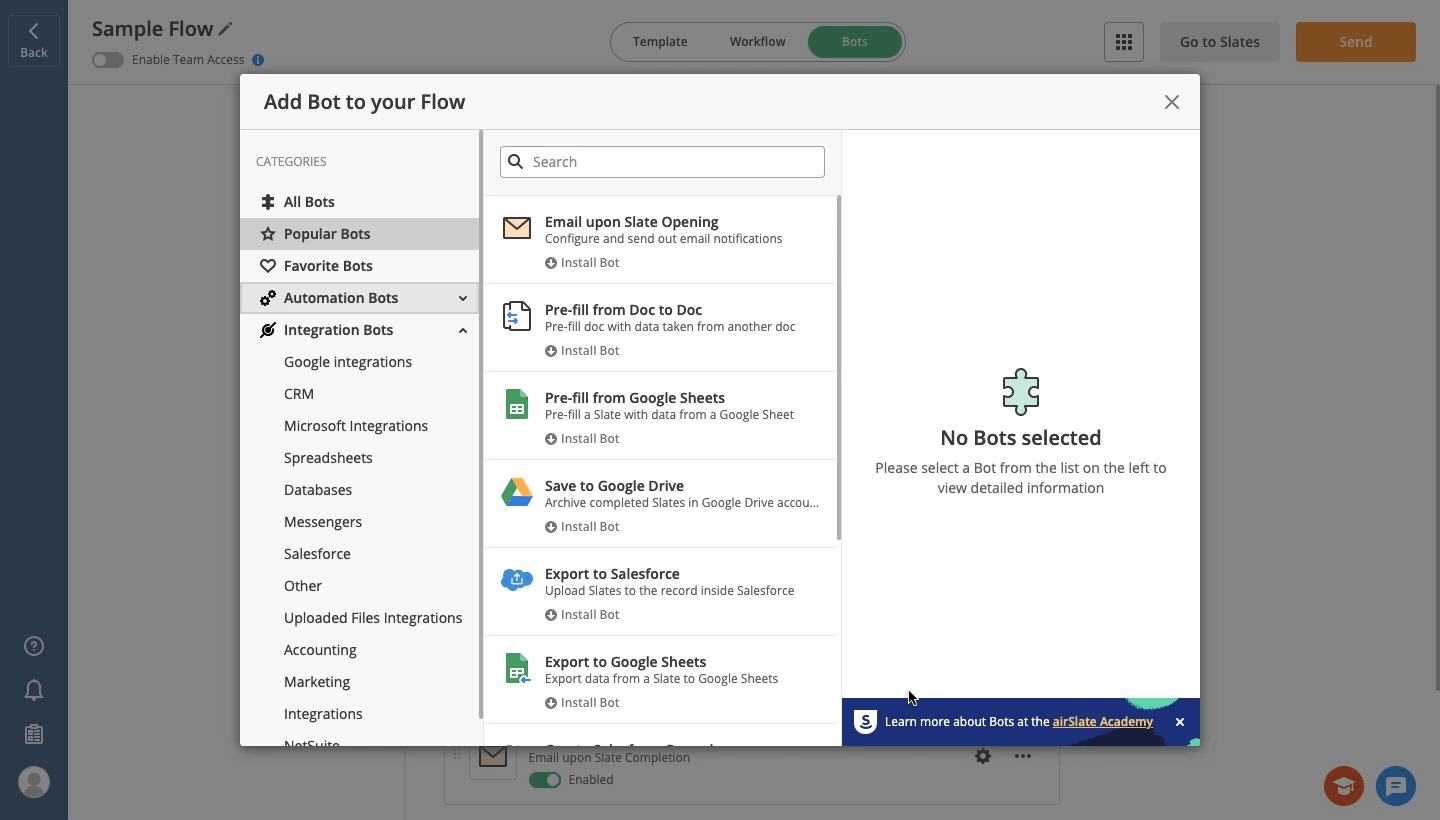
Looking for an easy way to export data from Salesforce to Google Sheets? This blog will walk you through the three most common methods for exporting Salesforce data. Most importantly, we’ll share step-by-step instructions on how to export data from Salesforce to Google Sheets using airSlate’s no-code Bots (Not an airSlate user? Sign up for free!).
What is a Salesforce data export?
In a nutshell, data export is a process of pulling data or data sets between various software applications. Salesforce data export is a native Salesforce functionality that implies creating a copy, extracting, and syncing Salesforce data into another format or application. One of the most common uses is exporting a Salesforce report to a downloadable spreadsheet in CSV format. In Salesforce, users can run the export process manually or automatically, on a weekly or monthly basis. Data export is a process of pulling data or data sets between various software applications. #nocode #automation @airSlateAcademy Share on X
3 reasons to export data from Salesforce
There are three reasons to perform a Salesforce data export:
- To retain Salesforce data in a separate file for the purposes of data analysis, reporting, and visualization.
- To backup data. The 2020 Salesforce Data Recovery Service’s retirement caused concerns among users. It later became known that Salesforce backup and restore services built natively on the platform will be available in summer 2021.
- To integrate a Salesforce account with a third-party app and import Salesforce data there.
How to export data from Salesforce to Google Sheets using airSlate Bots
In this chapter, we’ll focus on the three most common ways to automate a Salesforce data export – using airSlate’s no-code Bots, the native Salesforce Data Export tool, and/or a custom script.
How to automate your business processes with airSlate Bots
airSlate’s no-code Bots allow users to set up a fully automated no-code workflow designed to fit specific business needs, including data transfers. In a very general sense, bots are software robots that perform actions based on pre-set conditions and are triggered to act when a Slate (package of documents) is opened or after it’s been edited.
Using no-code bots doesn’t require any special technical skills, which makes the process easy and intuitive for business users. When properly configured, bots can complete a vast scope of tasks without any further action from the user.
In airSlate, Bots are split into two categories based on their mode of operation:
- Automation Bots are used to manage access control to documents, send notifications and reminders to the intended recipients, and so on.
- Integration Bots are used to build connections with third-party services like CRM systems, databases, systems of record, and others.
airSlate’s integration Bots include various data export bots, which allow users to automate data exports from third-party software including CRMs, databases, productivity applications, etc. Using these bots allows users to eliminate issues associated with manual data entry and ensure the accuracy of business data. To export Salesforce data to Google Sheets, you will need to leverage two integration Bots – the Pre-fill from Salesforce Record Bot and the Export to Google Sheet Bot.
Follow the steps below to perform a Salesforce data export to Google Sheets using airSlate Bots:
Complete the following steps before you start using airSlate Bots:
- To start working with documents, create a Flow that can later be connected to integration or automation Bots.
- Add the documents you intend to use.
- Set up Bots to automate the data transfer.
The process of a Salesforce data export to Google Sheets with airSlate involves two stages:
1) exporting data from your Salesforce record to the Slate (a document or spreadsheet).
2) moving this data from the Slate to a Google Sheet.
Make sure that your airSlate workflow is properly configured before exporting Salesforce data to Google Sheets.
Once you’ve uploaded the necessary document(s) or created them from scratch, you will need to set up two airSlate integration Bots:
- The Pre-fill from Salesforce Record Bot
- The Export to Google Sheet Bot
Follow the step-by-step instructions below to configure the Pre-fill from Salesforce Record Bot:
- Connect your Salesforce account to your airSlate workflow and select the instance you will use: Production, Sandbox, or Custom URL.
- Choose the Salesforce base object with the record you need (e.g., you want to export Contacts from Salesforce).
- Set the correspondence between the Salesforce record fields and the document fields (where you will export the data).
- Select the Bot execution condition that will trigger the Bot to act (e.g., the Bot will be triggered once a specific field in the document is filled in).

Once the execution condition is fulfilled, the data will be automatically exported from the indicated Salesforce record to your document.
To move the exported data from the document to a Google Sheet, set up the Export to Google Sheet Bot:
- Connect your Google account to your airSlate workflow and select the Google Sheet you intend to populate with data.
- Set the correspondence between the document fields and the fields in the Google Sheet.
- Select the Bot execution condition that will trigger the Bot to act.
Once the execution condition is met, the data will be automatically exported from the document to the selected Google Sheet.

How to export data using native Salesforce functionality
The native Salesforce Data Export tool allows users to pull data from Salesforce once per week/month and/or schedule mass exports once a month. Once the export is configured, the Data Export tool emails a link to a downloadable CSV file the Salesforce user has to manually download on their device.
On the one hand, using a native tool within the Salesforce environment is convenient, since it doesn’t require any third-party apps or plug-ins. On the other hand, the native Salesforce Data Export tool only automates half of the process, as users still have to download the CSV file manually.
Follow the step-by-step instructions below to set up a Salesforce data export using the Data Export tool:
1. Start by clicking Setup, then expand Data Management on the left side of the screen, and then click Data export.
2. You will be presented with two options – “Export Now” or “Schedule Export”.
The “Export Now” option allows users to manually extract Salesforce data once per month. Users of Enterprise, Performance, and Unlimited Editions can export data every week.
Select the data you intend to export, then click Save. Once the file(s) are ready for download, you will receive an email notification.
Take note: the exported file(s) will be available for download for 48 hours. Click Download to retrieve the ZIP archive containing the CSV file to your device.
3. The “Schedule Export” option allows for automating the process of executing a Salesforce data export on a monthly basis. Set the frequency, select the data you need exported, and then click Save.
Take note: the exported data will be pulled automatically into a CSV file on the schedule you’ve set. After that, you’ll need to manually save it to your device.
How to export Salesforce data using a custom script
The Salesforce platform can be expanded with the pre-programmed Extract, Transform, Load tool or script. ETL refers to the procedure of pulling data from one or several sources into a destination system which then processes the data and represents it differently from the source or in a different context.
An ETL tool/script is capable of extracting data from Salesforce into CSV format and outputting the aggregated files in a target destination for analysis or retention. For instance, a custom script in Python or Ruby allows for automating the process of downloading files from Salesforce to a local computer. After that, a script sends out an email notification per the download’s completion or failure.
Overall, configuring a custom script is a great option for both tech-savvy users or if there’s a way to leverage the IT department. On the other hand, for an average business user, pre-programming a script to automate a Salesforce data export requires technical skills and knowledge of programming they simply may not have.
Learn more about airSlate’s native integration with Salesfloce by watchig the video below:
Learn how to export Salesforce data with the airSlate Academy
At the airSlate Academy, we educate our potential and existing customers about workflow automation and how it applies to specific industries and business needs. The airSlate Academy offers a selection of free courses and certification programs covering topics from automation fundamentals to mastering the most popular airSlate Bots for no-code business automation.
Discover the courses focused specifically on Salesforce integration Bots:
- The Export to Salesforce course will teach you how to automatically upload a Slate (i.e. a document or a collection of documents) to a Salesforce record. For instance, if you need to attach a document to a specific Salesforce record, the Export to Salesforce Bot will come in handy.
- The Pre-fill from Salesforce Record course will help you automatically export Salesforce data and transfer it to a Slate (a document or a spreadsheet). For instance, you can use this Bot to extract Salesforce leads, contacts, etc., to a report, contract, or any other document you’ve uploaded to your Flow.
- The Create Salesforce Record course will provide you with all the necessary instructions on how to generate a new Salesforce Record by transferring data from a Slate once it’s completed. For instance, once a client’s registration form is filled out, you need to automatically transfer its data to create new leads in Salesforce — the Create Salesforce Record Bot will do the job for you.
- The Update Salesforce Record course will teach you how to update the existing Salesforce record with data from a Slate once it’s completed. For instance, whenever you need to update a client’s contact information with the data from a completed survey, use the Update Salesforce Record Bot.
Streamline your business workflows with the airSlate Academy
- What is a Salesforce data export?
- 3 reasons to export data from Salesforce
- How to export data from Salesforce to Google Sheets using airSlate Bots
- How to export data using native Salesforce functionality
- How to export Salesforce data using a custom script
- Learn how to export Salesforce data with the airSlate Academy
